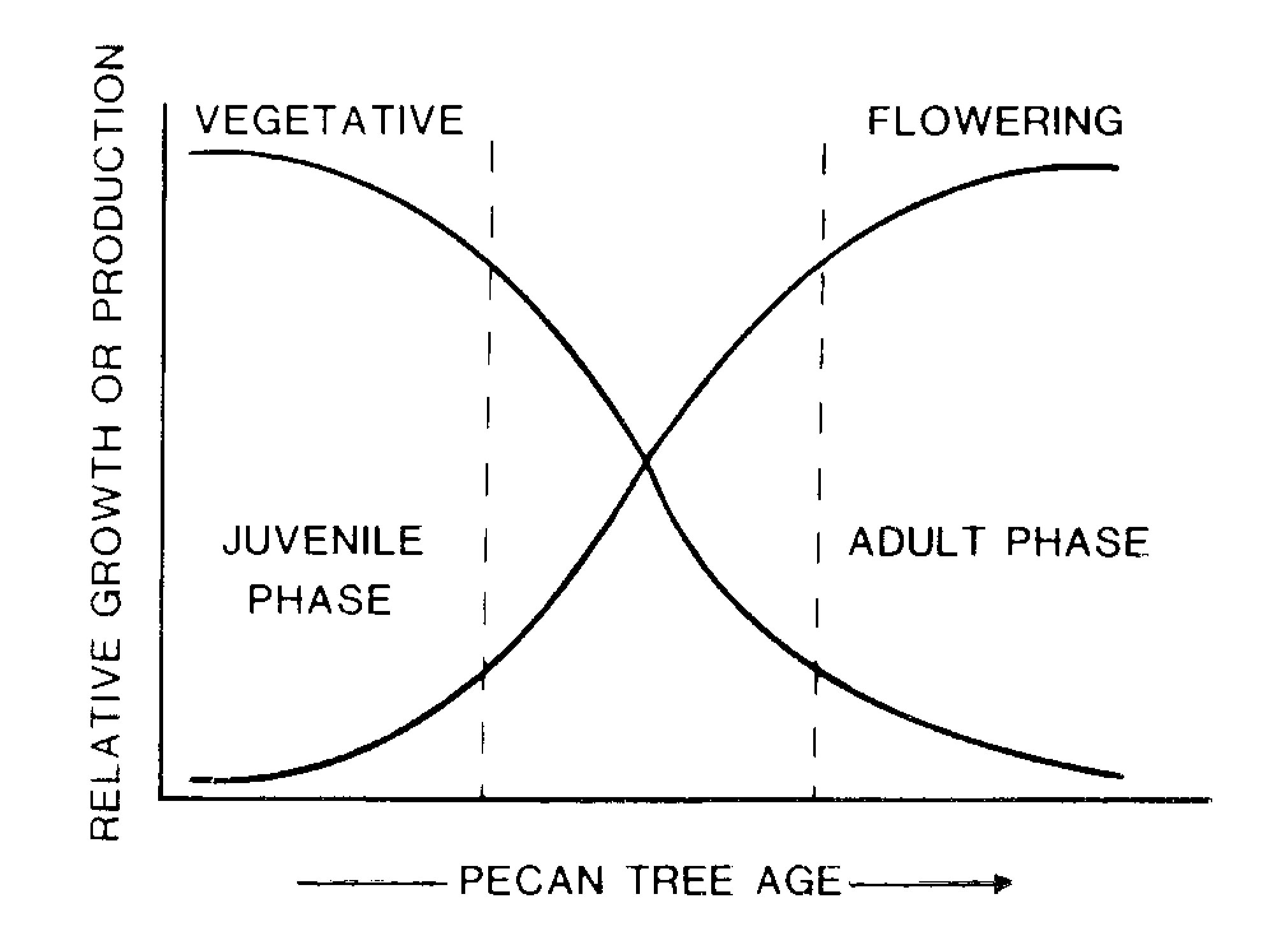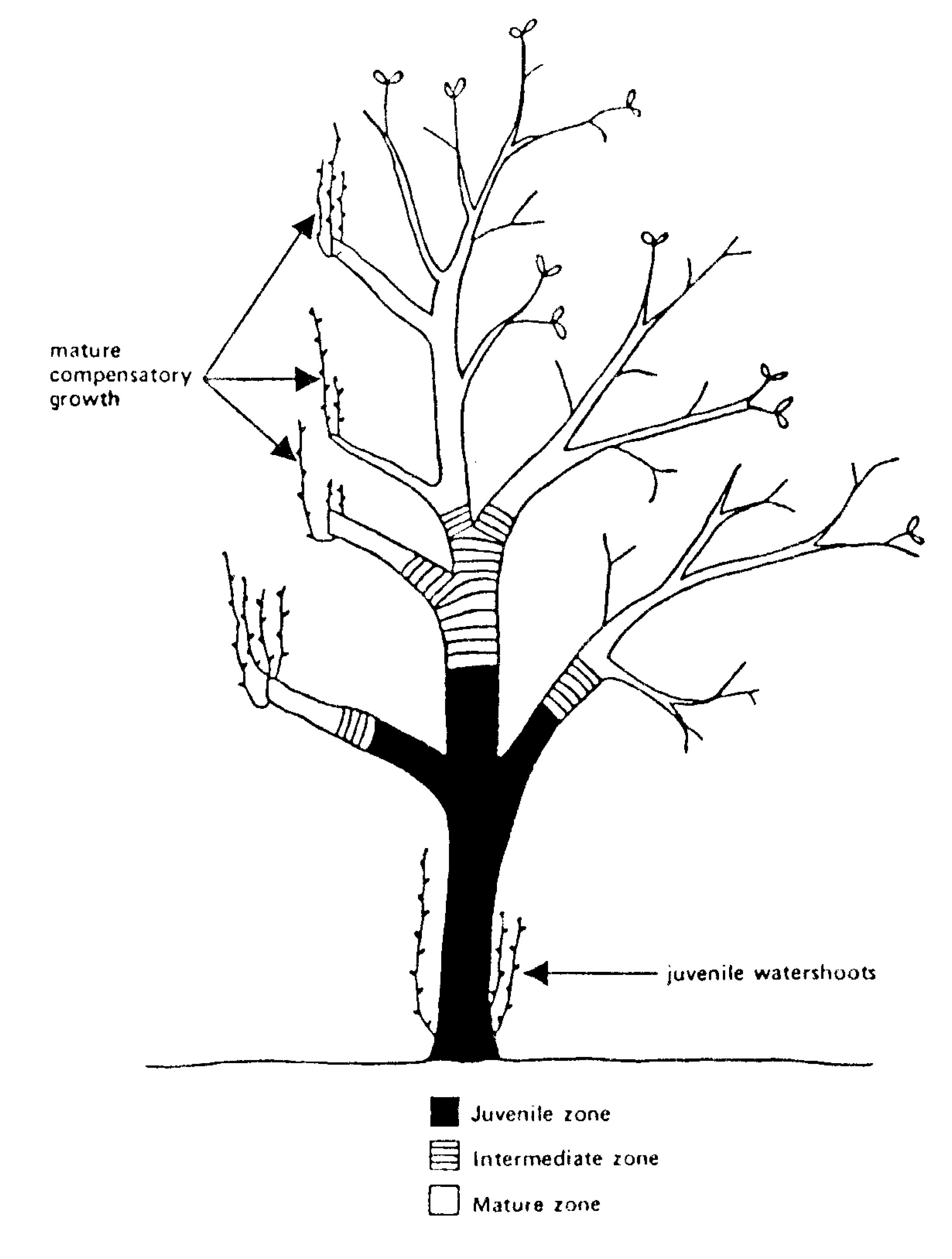Guide H-616
Esteban Herrera, Extension Horticulturist
College of Agriculture, Consumer and Environmental Sciences New Mexico State University. (Print Friendly PDF)
Pecan trees and most other woody plants have two distinct growth phases relative to the time the plants begin to bear fruit. The juvenile phase is the period when young trees cannot be induced to flower, even when exposed to appropriate conditions. The adult phase is initiated by the tree's ability to flower (fig. 1). There are other morphological changes that take place in pecans, in addition to flowering. These phenomena occur gradually rather than abruptly.

Fig. 1. Juvenile and adult phases in pecan seedling in relation to tree age.
True juvenility applies only to seedling plants, those grown from seed. The non-flowering vegetative phase of asexually propagated plants (budded or grafted) is a different situation.
Seedlings
Juvenility is a process that gradually declines over several years from the time a seed germinates until the tree begins fruit production. Pecan seedlings are characterized by rapid vegetative growth after seed germination. Typically, the young seedlings cannot be induced to flower during this period. A pecan tree will usually grow vigorously for the first 5 to 10 years, then vegetation growth declines as fruit production begins to increase.
Juvenile features of pecan leaves are pronounced pubescence (hairiness), especially along the lower surface, midrib, and main veins, and a reddish coloration of young leaves and shoots in spring. Leaf pubescence and red coloration in pecan seedlings are less pronounced in the first year of growth, and more intense in the third year. Leaves formed in the first season are simple and entire (without leaflets).
Young tree seedlings typically show a juvenile branching pattern, with a few long, whip-like shoots and narrow crotch angles in the early years. It is not uncommon for shoot growth to extend 3 to 6 feet in a single season. This is because there are fewer growing points (branches) on the tree, competition from other trees is minimal, and no energy is going into fruit production.
Bark appearance is also different in the two phases. In the juvenile phase of pecan seedlings, there is heavier development of protective bark layers than in the adult part of the tree. The different types of bark are distinctly evident in budded or grafted pecan orchard trees. Because the rootstock was a juvenile seedling, the bark below the bud (graft) union is juvenile or rough in texture. Adult type bark is smoother and is found above the union because the tree from which budwood (graftwood) was taken was in the adult phase (many years removed from seed). Usually, the demarcation line at the union is sharp, clearly separating the rough juvenile bark from the budded top. As the grafted tree ages, the upper bark tends to flake off in large sectors while that of the rootstock is retained more tenaciously.
There is a graduation of juvenility on a given seedling tree. These position effects have been called topophysis and are a consequence of the way a tree grows. It seems the root crown and trunk are in the juvenility phase, remaining juvenile both morphologically and physiologically. As a young tree continues to grow, a shoot-root transition or intermediate zone develops because the juvenile influence from the root crown is diluted. Finally, at the top of the leader shoots (youngest shoots), the adult phase or mature wood is found with the capacity to flower (fig. 2). First flowers on seedling trees thus tend to occur in the peripheral and upper zones of the tree, especially on shoots of favorable length and thickness with high stored food reserves.

Fig. 2. Topophysis effects in seedling trees.
Adult Phase. Mature (adult) type leaves have a smooth, shiny luster compared to the dull, pubescent leaves found in the juvenile stage.
Maturation occurs gradually in trees and does not necessarily involve every feature at the same time. There is no exact point at which the phase change from juvenile to adult takes place. Once a tree has progressed in time from the juvenile to adult stage, it still may be largely vegetative but is capable of producing flowers. As it ages further, the ratio of fruiting to vegetative growth increases gradually until it reaches a point where all parts of the tree are capable of producing flowers (figs. 1 and 2).
Budded Trees
A different situation exists on commercially planted trees in New Mexico, which are usually from pecan tree nurseries where buds are taken from bearing trees and propagated onto seedling rootstocks. The bud is not juvenile and all growth from it is adult. The bud often produces a fruiting shoot the first year. A young grafted tree which has not yet produced fruit should not be considered juvenile. It is merely in the adult vegetative stage (fig. 1).
Another characteristic difference between adult vegetative trees and juvenile seedlings is the location of the first fruit production. The juvenile tree usually produces first in the upper branches. The adult tree usually remains vegetative in the top, and will flower and fruit in lower branches. The latter situation is probably the result of more intense sunlight in the upper tree branches allowing more vigorous growth. Such vigorous shoot growth does not favor flower production.
To find more resources for your business, home, or family, visit the College of Agricultural, Consumer and Environmental Sciences on the World Wide Web at pubs.nmsu.edu
Contents of publications may be freely reproduced for educational purposes. All other rights reserved. For permission to use publications for other purposes, contact pubs@nmsu.edu or the authors listed on the publication.
New Mexico State University is an equal opportunity/affirmative action employer and educator. NMSU and the U.S. Department of Agriculture cooperating.
February 2000, Las Cruces NM


